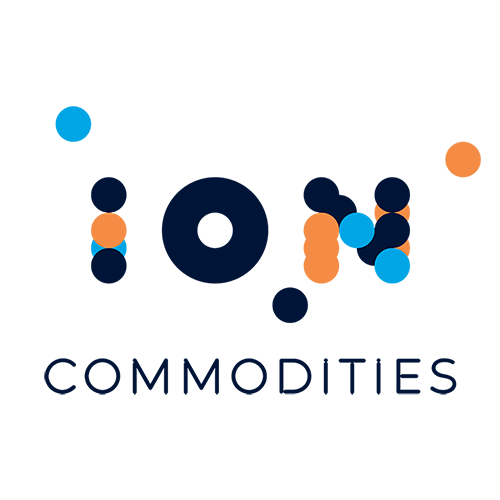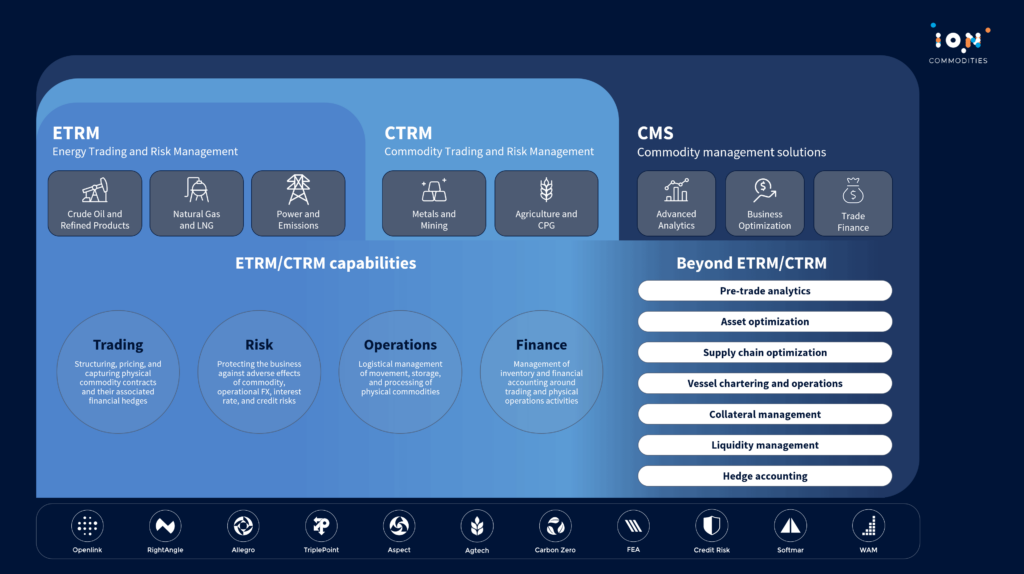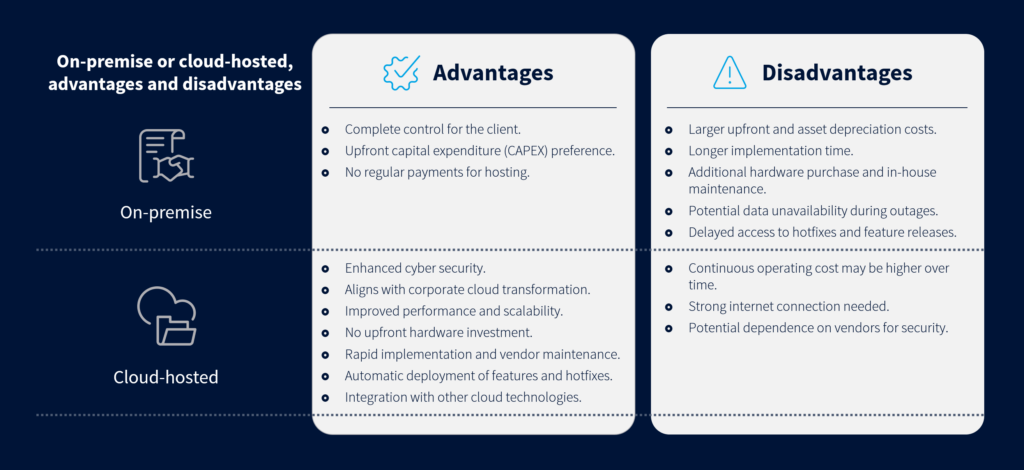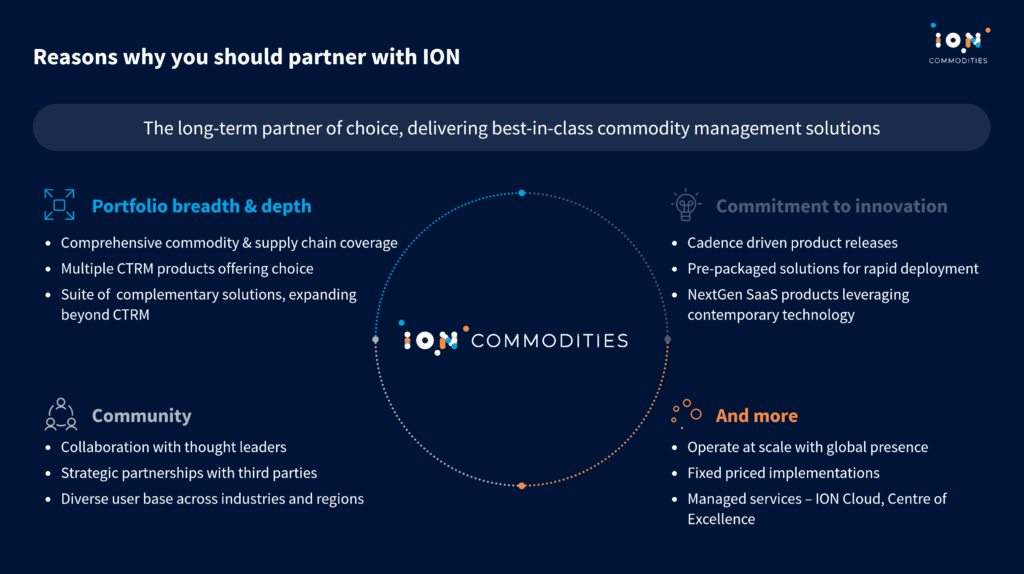Commodity Management Solutions: Beyond traditional CTRMs/ETRMs
Why traditional CTRM/ETRM is no longer enough
Commodities are the driving force of global trade. They impact the lives of everyone around the world. But they are susceptible to disruptions. Over the past few years, a convergence of events — geopolitical tensions and conflicts, supply chain disruptions, demand fluctuations, and extreme weather conditions — has led to unprecedented price volatility and unpredictability across commodity markets.
Against this backdrop, product proliferation, increased regulatory compliance, and the appearance of new markets, such as renewable certificates and carbon markets, has created another set of challenges for businesses operating in the energy and commodity space.
With these challenges come opportunities. And to capitalize on these opportunities, energy and commodity businesses need to evolve. Whether dealing with oil and gas, power and renewables, metals, or agricultural products — a clear understanding of risk, inventories, purchase and sale obligations, and logistical movements has become essential for optimizing business operations, improving profitability, and navigating market volatility.
So, how can they tackle these obstacles and evolve their business? How can they effectively safeguard and maximize their bottom line, improve trading performance, streamline business workflow, mitigate risks, and so on?
They can embrace innovative Commodity Management Solutions (CMS) that equip their business to navigate through today’s challenges.
What are Commodity Management Solutions?
ETRMs, CTRMs, and CMS
ETRM, standing for Energy Trading and Risk Management, specializes in the intricate world of energy-related commodities like electricity/power, natural gas, oil, and refined products. Its primary focus is on the nuances and challenges within the energy sector, offering tailored solutions to support the energy commodity trading and marketing trade life cycle combined with physical operations, integrated risk management, and reporting.
CTRM, standing for Commodity Trading and Risk Management, refers to a broader category that includes an additional range of non-energy commodities. CTRM encompasses agricultural products such as wheat, corn, and soybeans, as well as metals like gold, silver, and copper, and soft commodities such as coffee and sugar. CTRM offers a similar comprehensive and integrated approach to trading and risk management, combined with physical operations, integrated risk management, and reporting, but across all commodity classes.
CMS, standing for Commodity Management Solution, is a more extensive software classification. In recent years, a maturing commodity market and user community has seen additional value creation with CMS. Today’s market dynamics demand a more holistic approach where businesses seek more comprehensive solutions that offer full visibility throughout the commodity value chain. These advanced solutions go beyond traditional trading and risk management to encompass functionalities crucial for optimizing business operations, achieving operational efficiency, navigating energy transition challenges, and meeting sustainability targets.
The expanded functionalities of CMS also include essential components such as pre-trade analytics, asset optimization, credit and collateral management, vessel chartering, portfolio and supply chain optimization, hedge accounting, trade finance, and more. As businesses aim for a competitive edge and adapt to the changing energy and commodity markets, embracing a CMS becomes a strategic move for sustainable growth.
Business benefits of CMS
From heightened operational efficiency and risk mitigation to real-time data insights driving informed decision-making, the advantages are far-reaching. Whether you’re into crude oil and refined products, power and renewables, natural gas and LNG, metals and mining, agriculture and Consumer Packaged Goods (CPG), or environmental products, a CMS becomes a catalyst for agility and adaptability where change is the only constant. Here are some business benefits of a CMS:
Drive business growth
- Increase the number of commodities traded as new revenue streams are added to the portfolio.
- Scale and handle increased volumes of transactions with ease.
- Expedite decision-making with consistent, accurate, and real-time insight across the business.
- Gain a complete view of exposure and P&L and ensure business resiliency.
Increase efficiency
- Connect the front, middle, and back-office for full transparency.
- Reduce time in trade life-cycle management.
- Expedite reconciliation and reduce time spent on back-office processes.
- Automate and streamline repetitive processes via AI/ML.
Mitigate risk and manage compliance better
- Mitigate risk and exposure with effective pricing and hedging strategies.
- Reduce time managing counterparty risk and defaults.
- Reduce time spent monitoring trader limits.
- Ensure compliance with international regulations.
Manage IT investment
- Consolidate the number of systems required and vendor agreements.
- Minimize system maintenance effort and cost.
- Reduce the need for additional systems to meet new business needs as they evolve.
- Benefit from standardized integration and speed up implementation time.
How is a CMS relevant to my business function?
A CMS is a versatile tool that caters to specific needs across the business. Whether optimizing trading strategies, managing risk, streamlining operations and logistics, or ensuring compliance, a CMS adds significant value across the board.
Benefits of a CMS for executive management
Informed decision-making
- Enhance visibility into critical business metrics and performance indicators.
- Provide real-time insights for swift and “data-informed” decision-making.
- Maximize profits across the energy and commodity value chain.
Strategic planning support
- Assist in strategic planning with comprehensive data analysis and forecasting.
- Enable scenario modeling for better preparation and risk mitigation.
Operational efficiency enhancement
- Identify opportunities to enhance operational efficiency and resource allocation.
- Reduce working capital by simplifying operational complexity.
- Streamline communication across the business.
Risk management and compliance monitoring
- Monitor risk and compliance adherence through integrated dashboards.
- Be prepared to handle any potential market disruptions and ensure business continuity.
- Receive alerts and reports on key risk indicators and compliance metrics.
- Integrate sanctioning monitoring into the trade lifecycle.
Benefits of a CMS for trading and marketing (Front office)
Advanced pre-trade analytics
- Achieve consistency in analytics from pre-trade to contract execution.
- Analyze, forecast, and simulate scenarios to predict potential outcomes with full transparency.
- Evaluate mark-to-market, storage facilities, available liquidity, spread costs, and market impact while making trading decisions.
Portfolio valuation
- Revalue portfolios in real-time with the latest market prices.
- Assess the impact of logistical movements on positions promptly.
- Gain intraday decision support to act on available opportunities.
- Purchase/sell commodities with a full understanding of the profit’s sensitivity.
Position and P&L reporting
- Analyze portfolios with accurate physical and financial positions.
- Drill into portfolio and trading details to unlock insights and maximize profitability.
- Take advantage of standard optimization models to evaluate and schedule physical assets.
- Structure exposure and P&L reports aligned with business hierarchies.
Benefits of a CMS for risk management (Middle office)
Risk management and hedging
- Hedge and calculate extrinsic values through advanced simulations.
- Analyze and optimize portfolio hedging strategies in response to market movements.
- Align risk data with pre- and post-trade analytics for data consistency and accuracy.
- Bring stability and predictability to earnings with hedge accounting
Advanced portfolio risk analytics
- Revalue portfolios promptly with latest market prices and positions.
- Model hypothetical what-if scenarios to evaluate the potential impact of future events.
- Identify portfolio risks through value-at-risk, profit-at-risk, cashflow-at-risk
- Conduct stress tests to understand market, credit, and liquidity risks under various scenarios.
Benefits of a CMS for physical operations and logistics (Middle office)
Operational efficiency and optimization
- Automate schedules and increase planning and replanning agility.
- Optimize transportation routes, reducing risk, cost, and delivery times.
- Manage inventory levels and supply chain movements.
- Optimize asset utilization and minimize operational cost
Operational risk management
- Mitigate operational risk and ensure accurate execution of physical operations.
- Assess current and future inventories and contractual obligations effortlessly.
- Monitor risk associated with suppliers and other third parties in the physical supply chain.
- Ensure traceability and adherence to regulatory and quality standards.
Benefits of a CMS for compliance (Middle office)
- Automate compliance processes for increased efficiency and accuracy.
- Ensure auditability and compliance with international regulatory standards.
- Generate comprehensive compliance reports at the enterprise level.
- Adjust flexible reporting structure to align with evolving regulatory standards.
Benefits of a CMS for finance (Back office)
Efficient settlement, invoicing, and accounting treatment
- Generate accurate invoices with the latest trade and settlement data using a unified solution.
- Automate cash flow netting for streamlined settlements, reducing manual effort and errors.
- Ensure auditability and adherence to international accounting standards.
- Prove hedge effectiveness of financial derivatives activities.
Trade finance and consolidated financial reporting
- Manage price volatility and the complexity of trade finance instruments, such as letters of credit, bank guarantees, holding certificates, pledging, leasing, repo, and factoring.
- Generate enterprise-level reports with drill-down into cash flow details for capital allocation analysis.
- Customize reports to comply with evolving regulations, accounting standards, and internal governance.
Document management
- Automate high-volume confirmation and invoicing document generation.
- Manage documentation requirements, including shipping and insurance documents, which can be time-consuming and difficult to manage.
Information Technology (IT)
- Simplify IT infrastructure and ensure seamless data flow and compatibility through standardized integration.
- Anticipate and address potential issues related to scalability and system performance as the business grows.
- Manage the security of sensitive trading and risk data and implement robust cybersecurity measures.
- Overcome resistance to change and ensure effective training programs to facilitate smooth technology adoption.
When should I transition from spreadsheets to a CMS to manage my business?
Spreadsheets offer a starting point for small-scale trading endeavors, but they cannot keep pace as a company grows. The lack of automation, audit history, real-time views, and robust security measures on spreadsheets can compromise the accuracy and control needed for successful commodity trading. Consider transitioning to specialized systems like a CMS as your trade volume and complexity escalate, ensuring a seamless and reliable foundation for your expanding business operations.
Spreadsheets have many limitations, including:
- Absence of audit trail: No comprehensive audit history, making it challenging to trace changes and verify accuracy.
- Error-prone environment: Potential for errors, such as double entry and discrepancies between unsynchronized spreadsheets.
- Real-time visibility gaps: Lack of live views on critical information, hindering swift decision-making.
- Business control and security gaps: Limited integrated security measures and permissions, posing a risk to data integrity.
- Time-consuming and unwieldy: Cumbersome data collection and maintenance, leading to a manual and often arduous process that hinders efficiency.
- Risk of losing proprietary analytics knowledge: Departing quantitative analysts carry crucial formulas and spreadsheet insights, making it impossible for the organization to retain proprietary knowledge and scale effectively.
Why do ERP systems fall short in handling commodities?
ERP (Enterprise Resource Planning) systems are known for their robustness and versatility, but their broad approach does not have the level of sophistication that commodity firms require. In the volatile and unpredictable commodity markets, relying on an ERP system can be inadequate.
From intricate commodity pricings to managing overall exposure, ERPs don’t provide sufficient tools for the front, middle, and back-office activities. They often need customizations that are expensive and require manual workarounds that could introduce potential errors and inefficiencies.
An ERP falls short on financial derivatives, hedging strategies, and risk management intricacies unique to commodity trading. Effective commodity risk management and financial decision-making involves managing positions, risk, and Value at Risk (VaR). Although ERP systems can handle quantity risk, they fail to manage price risk, which involves diverse instruments ranging from long-term contracts to financial derivatives like futures, swaps, and options.
Should I use an on-premise or cloud-hosted CMS?
Choosing between on-premise and cloud hosting is pivotal in selecting a CMS. The decision involves weighing the reliability of on-premise control against the agility and scalability offered by the cloud. Let’s delve into the pros and cons.
Why should I partner with ION?
ION solutions are utilized by 66% of the top 250 global energy companies. With 1,200+ customers and 30,000+ users overall, ION is constantly evolving solutions to better serve the commodities community. Here are some of the reasons why you should partner with ION:
Portfolio breadth and depth
ION distinguishes itself through an extensive portfolio of SaaS solutions to highly customizable CMS platforms that boast comprehensive commodity and supply chain coverage. We understand that no two organizations are the same. Our customers benefit from a diverse range of best-in-class ETRM and CTRM products. ION offers customers the flexibility to choose products that align precisely with their business needs and the types of commodities they deal with. At ION, we go beyond traditional CTRM and ETRM products. For value-added benefits, these products can be combined with ION’s complementary products and services. The combined offering ensures that ION customers have access to a CMS for managing their operations efficiently and empowering them to buy, sell, hedge, trade, forecast, produce, refine, blend, schedule, move, store, invoice, settle, and report – all in one place.
Community
Collaborative innovation thrives at ION, as evidenced by our strong community engagement. We actively collaborate with thought leaders, foster strategic partnerships with third parties, and maintain a diverse user base across industries and regions. This dynamic community not only facilitates the exchange of valuable insights but also creates an ecosystem where businesses can tap into a wealth of collective knowledge and experience. At ION, we actively engage with our community to discuss industry trends and best practices and tackle critical topics such as market standardization and energy transition.
Commitment to innovation
ION’s commitment to innovation sets ION apart in the market. By constantly collaborating with our 30,000+ users’ community, together we shape our roadmap and transform commodity management to ensure we continue to support the distinct needs of the industry. Our products follow a cadence-driven release cycle, ensuring clients stay at the forefront of technological advancements. We offer pre-packaged solutions for rapid deployment, allowing businesses to swiftly adapt to changing needs. Our recently introduced NextGen SaaS products leverage contemporary technology, providing clients with cutting-edge solutions that align with the demands of the modern business landscape.
And more
Beyond our award-winning solutions, businesses working with ION also benefit from several additional advantages. Our global presence enables clients to operate at scale, reaching diverse markets with efficiency. We offer fixed-priced implementations, providing transparency and predictability in project costs. Furthermore, our managed services, including ION Cloud and a dedicated Center of Excellence, ensure that clients receive ongoing support and optimization, maximizing the long-term value of their partnership with ION.
ION Commodities product portfolio
ION offers a range of CTRM/ETRM products to meet the diverse needs of the commodities businesses.
CTRMs/ETRMs
ION’s portfolio includes a suite of best-in-class CTRM and ETRM products like Agtech, Allegro, Aspect, Openlink, RightAngle, and TriplePoint.
- Agtech is a feature-rich, SaaS solution designed for agricultural origination and marketing.
- Allegro is a comprehensive solution designed for utilities and power companies that market, trade and risk manage electricity, natural gas, or renewable energy.
- Aspect is a multi-tenant, SaaS solution designed for traders, refiners, producers, and marketers of liquid hydrocarbons, metals as well as environmental products.
- Openlink is a comprehensive, multi-commodity solution for industry leaders operating at scale with sophisticated needs around risk and physical logistics.
- RightAngle is a solution with robust scheduling and logistics capabilities for liquid hydrocarbon companies such as producers, crude marketers, refiners, fuel marketers, and fuel consumers.
- TriplePoint is an out-of-the-box, multi-commodity solution best suited for small to medium-sized companies with trading, physical operations, and price risk management needs.
Complementary products
ION’s CTRM and ETRM products can be combined with 11 distinct complementary products to unlock additional value and business optimization. These include solutions for advanced risk analytics (FEA), environmental products and carbon credits (Carbon Zero), credit and counterparty management (Credit Risk), supply chain optimization (WAM), and vessel chartering and operations (Softmar).
CMS as a strategic solution
The traditional ETRM/CTRM meets the complexities of today’s commodity markets, but to thrive, businesses need a CMS evolving for tomorrow and beyond. ION is paving the way with its innovative CMS, empowering the commodities community to invest for the future with a partner building for the long-term.

Don't miss out
Subscribe to our blog to stay up to date on industry trends and technology innovations..





